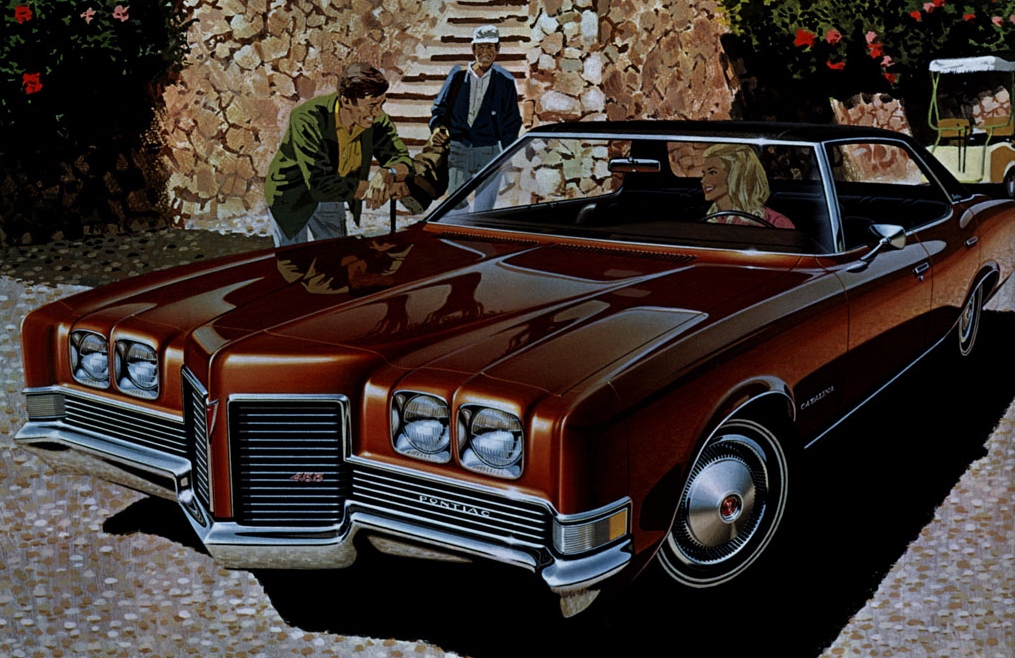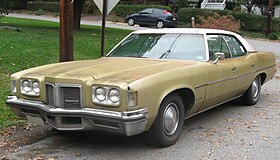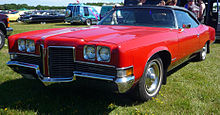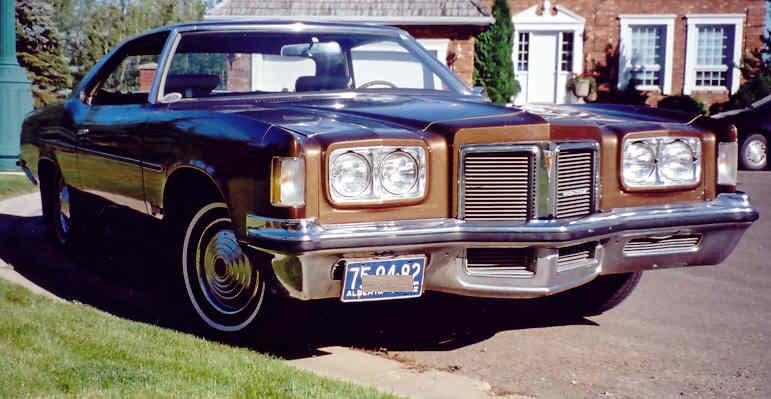>NAME this Ride (?) What make, year, model is this (?)
#221
#222

1972 Pontiac Catalina 2 Door Hardtop ? ? ? ? ? ? ? ? ? ?



1971–1976[edit]

material may be challenged and removed. (May 2014)Fourth generation OverviewProduction1971–1976Body and chassisBody style4-door sedan
OverviewProduction1971–1976Body and chassisBody style4-door sedan
4-door hardtop
2-door hardtop
2-door convertible
4-door station wagonPowertrainEngine355 cu in (5.8 L) "350" V8
400 cu in (6.6 L) V8
455 cu in (7.5 L) V8Transmission3-speed THM400 automaticDimensionsWheelbase123.4 in (3,134 mm)

For 1971, Catalina and other full-sized Pontiacs were completely redesigned and restyled from the wheels up with long hood/short deck proportions and fuselage styling somewhat similar to Chrysler Corporation's 1969 full-sized cars, along with a double shell roof for improved roll-over protection and flush pull-up exterior door handles - the latter two features first seen on the 1970 1⁄2 Firebird. Catalina and Catalina Brougham sedans and coupes rode on a 123.4-inch (3,130 mm) wheelbase while Bonneville and Grand Ville used a longer 126-inch (3,200 mm) wheelbase, and Safari wagons were an inch longer at 127 inches. Station wagons also got their own multi-leaf spring rear suspensions, while sedans and coupes continued to be suspended with front and rear coil springs.
New for 1971 was the Catalina Brougham series, which offered a more luxurious interior trim than the regular Catalina, available as a two-door hardtop, four-door hardtop and four-door pillared sedan. It was similar in concept to the Ventura series (1960-1961, 1966-1969) and the Ventura custom trim option on the Catalina (1962-1965, 1970). It was dropped in 1973 after its sales failed to meet expectations. 1972 also marked the final appearance of the Catalina convertible.
The Catalina Safari wagon became simply the Pontiac Safari for 1971 (though it continued to share interior and exterior trimmings with Catalina sedans and coupes) while the more luxurious Executive and Bonneville wagons were replaced by the new Grand Safari wagon. While the Grand Safari shared its grille design with the new Grand Ville series, its interior trim was identical to the optional vinyl interior offered on the Bonneville series. Pontiac now grouped its full-sized wagons as a separate series from their sedan counterparts, as did Chevrolet (Brookwood, Townsman, Kingswood, Kingswood Estate), Oldsmobile (Custom Cruiser), and Buick (Estate Wagon).
As did all GM B-Body wagons, the Safari and Grand Safari received GM's new clamshell tailgate. Operated by switches on the instrument panel or a key switch on the rear quarter panel, the tailgate slid into a recess under the cargo floor while the electric window slid upward into the rear roof section. Pontiac boasted the new system made it easier to load and unload the wagon in tight spaces, but the "Glide-Away" tailgate was prone to electrical and mechanical problems, and water and air leakage problems, as the cars aged.
Another trouble-prone feature Pontiacs shared with all GM B- and C-body cars for 1971 was a new power ventilation system. The system, also shared with the ill-fated Vega, used the heater fan to draw air into the car from the cowl intake, and force it out through vents in the trunk lid or tailgate. In theory, passengers could enjoy fresh air even when the car was moving slowly or stopped, as in heavy traffic. In practice, however, it didn't work.
Within weeks of the 1971 models' debut, however, Pontiac—and all other GM dealers—received multiple complaints from drivers who complained the ventilation system pulled cold air into the car before the heater could warm up—and could not be shut off. The ventilation system was extensively revised for 1972.
All models featured new Grand Prix-style wrap-around cockpit instrument panels that placed controls and instruments within easy reach of the driver along with two round pods for a speedometer and the other for warning lights, fuel gauge or optional gauges and electric clock. Interior trims were available in cloth and Morrokide vinyl or expanded Morrokide depending on model.
Standard engine in Catalina sedans and coupes was a 255-horsepower "350" (actually 355 cid) V8 with two-barrel carburetor. Catalina Brougham models and Safari wagons came standard with a 400 cubic-inch V8 with two-barrel carburetor rated at 265 gross horsepower that was optional on other Catalina models. Optional engines included a 455 cubic-inch V8 with two- or four-barrel carburetion and respective horsepower ratings of 285 and 325, respectively. All Pontiac engines for 1971 were designed to run on lower-octane regular leaded, low lead or unleaded gasoline thanks to a GM corporate edict, necessitating reductions in compression ratios.
Power front disc brakes were made standard equipment for the first time in 1971. As in previous years, variable ratio power steering and Turbo Hydramatic transmission were extra-cost options but became standard equipment midway through the 1971 model run. Also available on early 1971 Catalinas with the 350 engine was a two-speed automatic transmission in addition to the standard column-shift three-speed manual.
For 1972, Catalinas and other full-sized Pontiacs received new Grand Prix-style "V" nose grilles and sturdier front bumpers that could withstand crashes of up to 5 mph (8.0 km/h), a year ahead of the Federal standard that took effect in 1973, along with revised taillight lenses.
The two-barrel 400 cubic-inch V8 was standard on all Catalina/Brougham/Safari models rated at 175 net horsepower compared to 265 gross horses in 1971 thanks to a switch in power measurements from gross ratings which were measured by a dynometer with no accessories attached while the "net" figures were measured "as installed" in a vehicle with all accessories and emission gear hooked up. Optional engines included a two-barrel 455 rated at 185 horsepower (138 kW) and a four-barrel 455 rated at 250 horsepower (190 kW). The year 1972 was the last for the Catalina convertible and the Catalina Brougham series.
Catalina and other 1973 full-sized Pontiacs featured more full-width spilt grilles along with the now-federally mandated 5 mph (8.0 km/h) front bumper, and revised taillight lenses. Instrument panels continued the "wrap-around" theme but the two round gauges were housed in square pods. With the Catalina Brougham discontinued only the regular Catalina models and Safari wagons were offered this year. Catalinas and other full-sized Pontiacs including Bonnevilles and Grand Villes now rode on a common 123.4-inch (3,130 mm) wheelbaase for sedans and coupes though Safari and Grand Safari wagons continued on their own 127-inch (3,200 mm) wheelbase.
Catalina sedans and coupes came standard with a 350 cubic-inch V8 rated at 150 horsepower (110 kW) with a 170-horsepower 400 two-barrel optional and standard on Safari wagons. Optional engines included a 230-horsepower 400 four-barrel and 250-horsepower 455 four-barrel V8.

The 1974 Catalina and other big Pontiacs had a new Mercedes-like center split grille and revised rear styling with new 5 mph (8.0 km/h) bumpers on the aft end and license plate moved above the bumper. Two-door hardtop coupes featured new fixed triangular side windows, but kept the pillarless style with roll-down rear quarter windows, unlike Chevrolet, which eliminated the rolldown rear quarters in the Caprice and Impala Custom coupes. The four-door pillared and hardtop sedans were virtually unchanged from 1973. Interiors were much the same as 1973 except for a revised standard steering wheel and new cut-pile carpeting.
New to the option list were adjustable accelerator and brake pedals, a Pontiac exclusive (and seldom ordered), and a Radial Tuned Suspension that included the upgraded tires along with other suspension mods such as front and rear sway bars.
The 170-horsepower 400 V8 with two-barrel carburetor was now the standard engine on all models with a 225-horsepower 400 four-barrel and 250-horsepower 455 four-barrelV8 available as options. Also for 1974, the Safari wagon was renamed the Catalina Safari and continued to share interior and exterior trims with sedans and coupes.
The year 1975 brought revised front and rear styling to Catalinas and other full-sized Pontiacs, along with standard radial tires and electronic ignition. The same assortment of 400 and 455 engines carried over from 1974 with reduced horsepower ratings ranging from 170 to 200, but now mated to catalytic converters, which provided improved driveability and fuel economy over previous emission control equipment, but mandated the use of unleaded gasoline. Four-door pillared and hardtop sedans featured new six-window styling with the sixth window on the hardtop sedan functioning as an opera window. 1975 also marked the end of Pontiac convertible production until 1982; the Grand Ville Brougham was the last full-size Pontiac convertible.
For 1976, only minor detail changes were made to Catalinas and other full-sized Pontiacs that included revised grilles (with rectangular headlights now on Catalinas with the "Custom Trim Option-round headlights continued on base models) and taillight lenses. This year was the last for the 1971-vintage bodyshell, optional adjustable pedals, 455 V8 and the clamshell tailgate on Safari wagons. 1976 also marked the return of the Bonneville Brougham series to the top of the full-size line, as Pontiac marketers abandoned the Grand Ville name entirely.

material may be challenged and removed. (May 2014)Fourth generation
 OverviewProduction1971–1976Body and chassisBody style4-door sedan
OverviewProduction1971–1976Body and chassisBody style4-door sedan4-door hardtop
2-door hardtop
2-door convertible
4-door station wagonPowertrainEngine355 cu in (5.8 L) "350" V8
400 cu in (6.6 L) V8
455 cu in (7.5 L) V8Transmission3-speed THM400 automaticDimensionsWheelbase123.4 in (3,134 mm)

1971 Pontiac Catalina convertible
For 1971, Catalina and other full-sized Pontiacs were completely redesigned and restyled from the wheels up with long hood/short deck proportions and fuselage styling somewhat similar to Chrysler Corporation's 1969 full-sized cars, along with a double shell roof for improved roll-over protection and flush pull-up exterior door handles - the latter two features first seen on the 1970 1⁄2 Firebird. Catalina and Catalina Brougham sedans and coupes rode on a 123.4-inch (3,130 mm) wheelbase while Bonneville and Grand Ville used a longer 126-inch (3,200 mm) wheelbase, and Safari wagons were an inch longer at 127 inches. Station wagons also got their own multi-leaf spring rear suspensions, while sedans and coupes continued to be suspended with front and rear coil springs.
New for 1971 was the Catalina Brougham series, which offered a more luxurious interior trim than the regular Catalina, available as a two-door hardtop, four-door hardtop and four-door pillared sedan. It was similar in concept to the Ventura series (1960-1961, 1966-1969) and the Ventura custom trim option on the Catalina (1962-1965, 1970). It was dropped in 1973 after its sales failed to meet expectations. 1972 also marked the final appearance of the Catalina convertible.
The Catalina Safari wagon became simply the Pontiac Safari for 1971 (though it continued to share interior and exterior trimmings with Catalina sedans and coupes) while the more luxurious Executive and Bonneville wagons were replaced by the new Grand Safari wagon. While the Grand Safari shared its grille design with the new Grand Ville series, its interior trim was identical to the optional vinyl interior offered on the Bonneville series. Pontiac now grouped its full-sized wagons as a separate series from their sedan counterparts, as did Chevrolet (Brookwood, Townsman, Kingswood, Kingswood Estate), Oldsmobile (Custom Cruiser), and Buick (Estate Wagon).
As did all GM B-Body wagons, the Safari and Grand Safari received GM's new clamshell tailgate. Operated by switches on the instrument panel or a key switch on the rear quarter panel, the tailgate slid into a recess under the cargo floor while the electric window slid upward into the rear roof section. Pontiac boasted the new system made it easier to load and unload the wagon in tight spaces, but the "Glide-Away" tailgate was prone to electrical and mechanical problems, and water and air leakage problems, as the cars aged.
Another trouble-prone feature Pontiacs shared with all GM B- and C-body cars for 1971 was a new power ventilation system. The system, also shared with the ill-fated Vega, used the heater fan to draw air into the car from the cowl intake, and force it out through vents in the trunk lid or tailgate. In theory, passengers could enjoy fresh air even when the car was moving slowly or stopped, as in heavy traffic. In practice, however, it didn't work.
Within weeks of the 1971 models' debut, however, Pontiac—and all other GM dealers—received multiple complaints from drivers who complained the ventilation system pulled cold air into the car before the heater could warm up—and could not be shut off. The ventilation system was extensively revised for 1972.
All models featured new Grand Prix-style wrap-around cockpit instrument panels that placed controls and instruments within easy reach of the driver along with two round pods for a speedometer and the other for warning lights, fuel gauge or optional gauges and electric clock. Interior trims were available in cloth and Morrokide vinyl or expanded Morrokide depending on model.
Standard engine in Catalina sedans and coupes was a 255-horsepower "350" (actually 355 cid) V8 with two-barrel carburetor. Catalina Brougham models and Safari wagons came standard with a 400 cubic-inch V8 with two-barrel carburetor rated at 265 gross horsepower that was optional on other Catalina models. Optional engines included a 455 cubic-inch V8 with two- or four-barrel carburetion and respective horsepower ratings of 285 and 325, respectively. All Pontiac engines for 1971 were designed to run on lower-octane regular leaded, low lead or unleaded gasoline thanks to a GM corporate edict, necessitating reductions in compression ratios.
Power front disc brakes were made standard equipment for the first time in 1971. As in previous years, variable ratio power steering and Turbo Hydramatic transmission were extra-cost options but became standard equipment midway through the 1971 model run. Also available on early 1971 Catalinas with the 350 engine was a two-speed automatic transmission in addition to the standard column-shift three-speed manual.
For 1972, Catalinas and other full-sized Pontiacs received new Grand Prix-style "V" nose grilles and sturdier front bumpers that could withstand crashes of up to 5 mph (8.0 km/h), a year ahead of the Federal standard that took effect in 1973, along with revised taillight lenses.
The two-barrel 400 cubic-inch V8 was standard on all Catalina/Brougham/Safari models rated at 175 net horsepower compared to 265 gross horses in 1971 thanks to a switch in power measurements from gross ratings which were measured by a dynometer with no accessories attached while the "net" figures were measured "as installed" in a vehicle with all accessories and emission gear hooked up. Optional engines included a two-barrel 455 rated at 185 horsepower (138 kW) and a four-barrel 455 rated at 250 horsepower (190 kW). The year 1972 was the last for the Catalina convertible and the Catalina Brougham series.
Catalina and other 1973 full-sized Pontiacs featured more full-width spilt grilles along with the now-federally mandated 5 mph (8.0 km/h) front bumper, and revised taillight lenses. Instrument panels continued the "wrap-around" theme but the two round gauges were housed in square pods. With the Catalina Brougham discontinued only the regular Catalina models and Safari wagons were offered this year. Catalinas and other full-sized Pontiacs including Bonnevilles and Grand Villes now rode on a common 123.4-inch (3,130 mm) wheelbaase for sedans and coupes though Safari and Grand Safari wagons continued on their own 127-inch (3,200 mm) wheelbase.
Catalina sedans and coupes came standard with a 350 cubic-inch V8 rated at 150 horsepower (110 kW) with a 170-horsepower 400 two-barrel optional and standard on Safari wagons. Optional engines included a 230-horsepower 400 four-barrel and 250-horsepower 455 four-barrel V8.

1973 Pontiac Catalina
The 1974 Catalina and other big Pontiacs had a new Mercedes-like center split grille and revised rear styling with new 5 mph (8.0 km/h) bumpers on the aft end and license plate moved above the bumper. Two-door hardtop coupes featured new fixed triangular side windows, but kept the pillarless style with roll-down rear quarter windows, unlike Chevrolet, which eliminated the rolldown rear quarters in the Caprice and Impala Custom coupes. The four-door pillared and hardtop sedans were virtually unchanged from 1973. Interiors were much the same as 1973 except for a revised standard steering wheel and new cut-pile carpeting.
New to the option list were adjustable accelerator and brake pedals, a Pontiac exclusive (and seldom ordered), and a Radial Tuned Suspension that included the upgraded tires along with other suspension mods such as front and rear sway bars.
The 170-horsepower 400 V8 with two-barrel carburetor was now the standard engine on all models with a 225-horsepower 400 four-barrel and 250-horsepower 455 four-barrelV8 available as options. Also for 1974, the Safari wagon was renamed the Catalina Safari and continued to share interior and exterior trims with sedans and coupes.
The year 1975 brought revised front and rear styling to Catalinas and other full-sized Pontiacs, along with standard radial tires and electronic ignition. The same assortment of 400 and 455 engines carried over from 1974 with reduced horsepower ratings ranging from 170 to 200, but now mated to catalytic converters, which provided improved driveability and fuel economy over previous emission control equipment, but mandated the use of unleaded gasoline. Four-door pillared and hardtop sedans featured new six-window styling with the sixth window on the hardtop sedan functioning as an opera window. 1975 also marked the end of Pontiac convertible production until 1982; the Grand Ville Brougham was the last full-size Pontiac convertible.
For 1976, only minor detail changes were made to Catalinas and other full-sized Pontiacs that included revised grilles (with rectangular headlights now on Catalinas with the "Custom Trim Option-round headlights continued on base models) and taillight lenses. This year was the last for the 1971-vintage bodyshell, optional adjustable pedals, 455 V8 and the clamshell tailgate on Safari wagons. 1976 also marked the return of the Bonneville Brougham series to the top of the full-size line, as Pontiac marketers abandoned the Grand Ville name entirely.
Last edited by BeachBumMike; 06-08-2014 at 08:13 AM.
#223
That would be a '69. The '68 had only the upper and lower portion of the tail light lens. Between the upper and lower lenses is a piece of metal painted body color.
#224
 I have only seen one of these in person at a Car Show. Good Call!!!!! I believe they only Made them in 68 and 69 they were manufactured in Canada as I recall. Maybe you may have more History that can be shared.
I have only seen one of these in person at a Car Show. Good Call!!!!! I believe they only Made them in 68 and 69 they were manufactured in Canada as I recall. Maybe you may have more History that can be shared.
#225
Cloce, but not quite. You took the bait. The small detail you missed is the almost blacked out license plate "Alberta".
Wanna try again?
Wanna try again?
#227
Answer: The year was correct - 1972. But in Canada, that car was car the Pontiac Laurentian. The Parisienne was the Canadian counterpart of the American Bonneville (in the 70's and 80's at least). Its funny that for all the details SpaceRider posted, it didn't mention that
#228
Answer: The year was correct - 1972. But in Canada, that car was car the Pontiac Laurentian. The Parisienne was the Canadian counterpart of the American Bonneville (in the 70's and 80's at least). Its funny that for all the details SpaceRider posted, it didn't mention that

Hi `Brent, that was a good one 4-Sure!
If Mr Google doesn't know
 I Sure don't > LOL >
I Sure don't > LOL > 

OK, whose next to post the next vehicle ? Yes, it's YOU


#230
Answer: The year was correct - 1972. But in Canada, that car was car the Pontiac Laurentian. The Parisienne was the Canadian counterpart of the American Bonneville (in the 70's and 80's at least). Its funny that for all the details SpaceRider posted, it didn't mention that






















